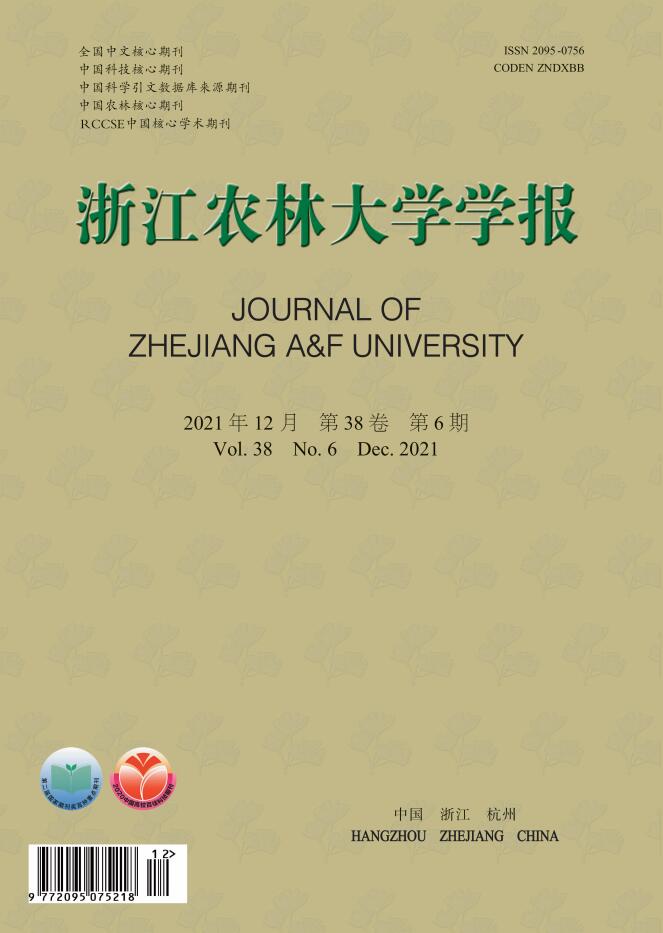-
化肥减量增效对农业可持续发展具有重要意义。2015年,农业农村部制定《到2020年化肥使用量零增长行动方案》[1],随后于2017年出台《开展果菜茶有机肥替代化肥的行动方案》[2],提出“精、调、改、替”4种技术策略以实现化肥使用量零增长,其中“替”就是用有机肥替代化肥从而减少化肥用量[3]。已有研究[4]表明:施用有机肥时,减少化学肥料用量并不会降低蔬菜产量。有机肥肥效周期长,能够促进土壤微生物活动,改良土壤结构;化肥养分释放周期短,营养供应速度快;将有机肥和化肥配合施用,不仅能弥补单施肥料的不足,还能充分发挥两者的优点,满足作物在生育期内对养分的持续需求,同时兼顾作物在生长和发育关键时期对养分的特殊需求[5−6]。茄Solanum melongena是中国南方露地栽培的主要蔬菜之一[7],目前关于茄栽培中肥料施用的研究,普遍侧重于减少养分流失、提高养分利用率等方面[8−10],而有关有机肥替代化肥对茄产量和品质影响的研究较少。本研究分析了不同比例有机肥替代化肥处理对茄花青素、氨基酸和营养元素等品质及产量的影响,同时分析土壤肥力的变化,以期为茄生产中化肥减量增效提供参考。
HTML
-
试验地位于浙江省龙泉市屏南镇百步村,该地属亚热带季风气候,年平均气温为17~18 ℃。供试土壤为红壤,基本理化性质:pH 4.81,碱解氮198.2 mg·kg−1,有效磷16.2 mg·kg−1,速效钾91.1 mg·kg−1,有机质22.4 g·kg−1,微生物碳282.8 mg·kg−1,微生物氮20.2 mg·kg−1,微生物碳氮比为14。
-
供试茄品种为‘杭茄2010’ S. melongena ‘Hangqie 2010’,由浙江省杭州市农业科学研究院提供;无机复合肥(氮16%,五氧化二磷6%,氧化钾23%,以质量分数计)购自深圳市芭田生态工程股份有限公司,有机肥(pH 7.6,氮2%,五氧化二磷4%,氧化钾2%,有机质83%,以质量分数计)购自浙江省龙泉市惠农生物科技有限公司。
-
本试验为大田试验。根据前人研究结果[11],按每生产1 000 kg茄子需要3.0 kg氮,以75 000 kg·hm−2为预期产量,设置施氮量240 kg·hm−2为施肥量基准。
以单施化肥(100%化肥)为对照(ck),设置T1处理为有机肥替代基肥中50%的化肥氮,T2处理为有机肥替代基肥中100%的化肥氮。设置3次重复,随机区组排列,田间常规管理完全相同。施肥方案见表1。
处理 施基肥/(kg·hm−2) 6月1日追
施复合肥/
(kg·hm−2)7月16日追
施复合肥/
(kg·hm−2)有机肥 复合肥 硼砂 ck 0 1 200 45 150 150 T1 4 245 600 45 150 150 T2 8 490 0 45 150 150 Table 1. Fertilization scheme
移栽前(2019年4月8日),按处理方案一次性施入全部基肥。选用长势一致、“三叶一心”的茄子幼苗进行移植,畦栽栽培,并用薄膜覆盖。5月11日定植,行距0.5 m,株距0.6 m。于挂果初期(2019年6月1日)和盛果期(2019年7月16日)追肥,施肥方法为水肥一体化,肥料随水灌入。
-
收获期内,各处理随机选取30株茄植株,统计并记录叶片数;采摘下最大功能叶,测定叶绿素相对含量(SPAD)[12],并用平台扫描仪结合Image J软件测定叶长、叶宽、叶面积[13]。果实采收时,各小区随机采摘10个果实,测量果实长度、直径、质量,总产量以实际称量结果计算。测定果实外观色差和模拟感官硬度[14];采用pH示差法测定果皮花青素质量分数[15];采用HPLC法测定果实维生素C质量分数[16];采用考马斯亮蓝G-250法测定可溶性蛋白质质量分数,采用蒽酮法测定果实可溶性糖质量分数[17];用Waters Acc Q-Tag法测定果实氨基酸质量摩尔浓度[18];果实氮质量分数采用凯氏定氮法测定,其他元素质量分数采用ICP-OES法测定[19]。
分别于种植施肥前和茄子收获后,按五点采样法用土壤螺旋钻于各处理小区随机取0~20 cm表层土壤样品;各处理土壤样品彻底混合后,四分法留样,过2 mm筛,鲜样测土壤微生物碳、氮(氯仿熏蒸浸提、TOC法测定)[20−21];剩余土壤风干后过1 mm筛,用重铬酸钾容量法测定土壤有机质,用碱解扩散法测土壤碱解氮,用碳酸氢钠浸提-钼锑抗比色法测土壤有效磷,用醋酸铵浸提-火焰光度计法测土壤速效钾,用电位法测土壤pH [22]。
-
采用Excel 2010处理数据和绘图,采用Data Processing System (DPS V14.10)分析数据,采用Duncan新复极差法进行差异显著性检验(P<0.05)。
1.1. 研究区概况
1.2. 试验材料
1.3. 试验处理
1.4. 测试指标及测定方法
1.5. 统计分析
-
由表2可知:相比ck,处理组土壤pH显著升高(P<0.05),土壤速效钾、有机质、微生物碳和微生物氮质量分数均显著增加(P<0.05),其中T1分别增加了87.6%、33.7%、61.5%和156.1%,效果最显著(P<0.05)。由表3可知:与T2和ck相比,T1土壤碱解氮质量分数显著增加,同时微生物碳氮比显著降低(P<0.05)。上述结果表明,相较于ck与T2,T1对土壤肥力的改善效果最佳。
处理 pH 碱解氮/(mg·kg−1) 有效磷 /(mg·kg−1) 速效钾/(mg·kg−1) 有机质/(g·kg−1) 微生物碳/(mg·kg−1) 微生物氮/(mg·kg−1) 微生物碳氮比 ck 4.3±0.1 b 188.2±6.5 b 21.1±1.9 a 201.8±4.1 c 41.6±1.2 c 389.0±2.5 c 47.8±0.9 c 8.1±0.2 a T1 5.1±0.1 a 385.7±6.7 a 22.1±3.9 a 378.5±1.8 a 55.6±3.6 a 628.3±1.4 a 122.4±2.1 a 5.1±0.1 b T2 5.0±0.1 a 182.6±13.2 b 22.0±1.5 a 255.7±3.8 b 45.4±2.4 b 509.8±1.1 b 60.6±1.0 b 8.4±0.1 a 说明:同列不同小写字母表示处理间差异显著(P<0.05) Table 2. Effects of different fertilization treatments on soil properties
处理 △pH △碱解氮/
(mg·kg−1)△有效磷/
(mg·kg−1)△速效钾/
(mg·kg−1)△有机质/
(g·kg−1)△微生物碳/
(mg·kg−1)△微生物氮/
(mg·kg−1)△微生物碳
氮比ck −0.5 −80.0 4.9 110.7 19.2 106.2 27.6 −5.9 T1 0.3 187.5 5.9 287.4 33.2 345.5 102.2 −8.9 T2 0.2 −15.6 5.8 164.6 23.0 227.0 40.4 −5.6 说明:△表示增量 Table 3. Effects of different fertilization treatments on soil properties before and after eggplant planting
-
由表4可知:相比ck,处理组茄植株茎粗显著增加(P<0.05),茄果实长度、果实直径显著增加(P<0.05),单果质量和单株结果数显著增加,产量大幅提升(P<0.05)。其中T1产量最高,为70 099.5 kg·hm−2,相比T2增产7.5%,相比ck增产22.3%。
处理 株高/cm 茎粗/mm 果长/cm 果直径/cm 单果质量/g 单株结果数/个 产量/(kg·hm−2) ck 106.8±6.3 a 21.3±1.1 c 25.7±1.6 b 2.3±0.1 b 60.0±7.0 b 8.4±2.5 c 57 300.0±1 501.5 c T1 105.2±5.8 a 26.8±1.3 a 27.6±1.5 a 2.5±0.1 a 72.2±3.4 a 16.2±3.8 a 70 099.5±1 552.5 a T2 105.1±5.3 a 24.4±1.3 b 27.3±1.7 a 2.4±0.2 a 71.7±11.8 a 12.3±2.3 b 65 200.5±1 819.5 b 说明:同列不同小写字母表示处理间差异显著(P<0.05) Table 4. Effects of different fertilization treatments on growth indexes of eggplant
-
由表5可知:相比ck,处理组叶片叶面积显著增加(P<0.05),其中T1叶面积最大,为226.5 cm2,较ck增加15.2%;SPAD由高到低依次为T1、T2、ck,其中T1叶片SPAD较T2增加了7.5%,较ck增加了14.1%。
处理 叶面积/cm2 叶片数 SPAD ck 196.6±3.6 c 94.2±29.6 a 74.6±3.9 a T1 226.5±6.3 a 100.1±16.8 a 69.4±2.9 b T2 215.6±9.3 b 99.2±8.7 a 65.4±4.8 c 说明:同列不同小写字母表示处理间差异显著(P<0.05) Table 5. Effects of different fertilization treatments on leaf area and leaf number and SPAD value of eggplant
-
由表6可知:相比ck,T1果皮硬度显著降低(P<0.05);3个处理茄果皮红绿色度(a*)均大于零,黄蓝色度(b*)均小于零,即颜色均在红蓝色区域;T1的红色葡萄果实颜色指数(CIRG)最大,为6.2,属于蓝黑,而T2和ck均属于深红色。相比ck,处理组果皮花青素质量分数显著增加(P<0.05),其中T1花青素高达13.3 mg·g−1,比ck增加了41.5%,比T2增加了16.7%。
处理 a* b* L* C 果皮硬度/N 花青素/(mg·g−1) ck 16.1±1.3 a −6.2±0.3 c 18.2±0.2 a 5.1±0.1 c 6.6±0.7 b 9.4±0.8 c T1 11.3±0.5 c −4.5±0.4 a 16.7±1.4 a 6.2±0.2 a 7.7±0.8 b 13.3±1.5 a T2 12.7±0.7 b −5.5±0.2 b 17.7±0.8 a 5.7±0.2 b 7.9±0.8 a 11.4±0.2 b 说明:a*表示果皮红绿色度,a*<0显示绿色,a*>0显示红色,数值越大果皮越红;b*表示果皮黄蓝色度,b*<0显示蓝色, b*>0显示黄色,数值越大果皮越黄;L*表示果皮亮度,L*=0显示黑色,L*=100显示白色,数值越大,果皮越亮。C为红色 葡萄果实颜色指数(CIRG),是间接反映花青苷质量分数及着色的重要值[23],与花青素质量分数达到了0.835的线性相关[24], C<2显示黄绿,2<C<4显示粉红,4<C<5显示红色,5<C<6显示深红,C>6显示蓝黑。同列不同小写字母表示处理间 差异显著(P<0.05) Table 6. Effects of different fertilization treatments on hardness and color of eggplant peel
-
由表7可知:相比ck,T1果肉硬度显著降低(P<0.05);处理组可溶性糖、可溶性蛋白质和维生素C质量分数分别增加了34.6%~56.8%、28.0%~33.3%和41.8%~122.2%。除可溶性蛋白质外,其他营养物质T1显著优于T2(P<0.05)。
处理 果肉硬度/N 可溶性糖/(mg·g−1) 可溶性蛋白质/(mg·g−1) 维生素C/(mg·g−1) ck 3.32±0.55 a 101.29±9.10 c 7.51±0.53 b 0.15±0.04 c T1 2.83±0.42 b 158.81±10.13 a 10.00±1.34 a 0.34±0.01 a T2 3.29±0.37 a 136.32±8.20 b 9.57±0.71 a 0.22±0.04 b 说明:同列不同小写字母表示处理间差异显著(P<0.05) Table 7. Effects of different treatments on hardness, soluble sugar, soluble protein and vitamin C content of eggplant fruit
-
由表8可知:相比ck,处理组蛋氨酸、苯丙氨酸、天冬氨酸、丝氨酸、甘氨酸和半胱氨酸质量摩尔浓度显著增加(P<0.05),其中除甘氨酸外,T1提升效果显著高于T2 (P<0.05);同时T1的缬氨酸、赖氨酸、异亮氨酸、亮氨酸、组氨酸和酪氨酸质量摩尔浓度显著高于ck (P<0.05),T2处理下苏氨酸、精氨酸、丙氨酸和脯氨酸质量摩尔浓度显著高于ck (P<0.05)。就必需氨基酸而言,T1达99.31 μmol·g−1,是ck的2.5倍,是T2的1.9倍,差异显著(P<0.05)。不同处理下茄非必需氨基酸总质量摩尔浓度由高到低依次为T2、T1、ck;相比ck,处理组氨基酸总量显著提高了80.8%~85.8% (P<0.05)。
处理 苏氨酸/
(μmol·g−1)缬氨酸/
(μmol·g−1)蛋氨酸/
(μmol·g−1)赖氨酸/
(μmol·g−1)异亮氨酸/
(μmol·g−1)亮氨酸/
(μmol·g−1)苯丙氨酸/
(μmol·g−1)ck 4.52±1.01 b 9.90±2.76 b 0.32±0.08 c 7.03±1.63 b 4.37±0.93 b 5.02±0.37 b 8.33±0.82 c T1 4.16±0.92 b 22.72±1.26 a 1.45±0.15 a 32.61±2.23 a 17.03±1.64 a 10.46±2.17 a 10.88±0.34 a T2 11.55±2.94 a 11.42±1.08 b 0.97±0.13 b 9.45±1.52 b 5.82±1.60 b 4.89±0.76 b 9.25±0.42 b 处理 天冬氨酸/
(μmol·g−1)丝氨酸/
(μmol·g−1)谷氨酸/
(μmol·g−1)甘氨酸/
(μmol·g−1)组氨酸/
(μmol·g−1)精氨酸/
(μmol·g−1)丙氨酸/
(μmol·g−1)ck 11.22±2.99 c 25.03±3.11 c 1.29±0.96 a 1.39±0.34 b 99.17±8.97 b 5.51±1.88 b 3.48±0.83 b T1 35.76±2.73 a 124.19±1.96 a 1.82±0.76 a 1.96±0.31 a 135.56±15.31 a 6.25±2.13 b 3.70±1.42 b T2 14.63±1.38 b 44.78±7.97 b 1.35±0.17 a 1.89±0.35 a 106.89±6.87 b 10.48±2.97 a 13.38±3.06 a 处理 脯氨酸/
(μmol·g−1)半胱氨酸/
(μmol·g−1)酪氨酸/
(μmol·g−1)必需氨基酸/
(μmol·g−1)非必需氨基酸/
(μmol·g−1)总氨基酸/
(μmol·g−1)ck 112.04±25.88 b 1.34±0.10 c 0.28±0.06 b 39.49±7.6 c 260.75±45.12 c 300.24±52.72 b T1 129.52±9.83 b 3.45±0.33 a 1.23±0.20 a 99.31±8.71 a 443.44±34.94 b 542.75±43.65 a T2 308.39±17.72 a 2.40±0.29 b 0.37±0.13 b 53.35±8.45 b 504.56±40.95 a 557.91±49.4 a 说明:同列不同小写字母表示处理间差异显著(P<0.05) Table 8. Effects of different fertilization treatments on the content of free amino acids in eggplant fruit
-
由表9可知:相比ck,处理组镁和硫质量分数显著增加,其中T1的果实硫质量分数较T2增加了10%,较ck增加了22.2%;T1的果实氮、磷、钾、钙、锰、锌和铁质量分数均显著增加(P<0.05),较ck分别增加了13.5%、26.5%、6.4%、18.8%、11.6%、21.0%和13.3%。
处理 氮/(mg·g−1) 磷/(mg·g−1) 钾/(mg·g−1) 钙/(mg·g−1) 镁/(mg·g−1) 硫/(mg·g−1) ck 19.23±0.77 b 3.42±0.20 b 31.38±1.60 b 1.59±0.14 b 1.09±0.10 c 0.18±0.02 c T1 21.78±0.41 a 4.31±0.13 a 33.41±1.42 a 1.90±0.07 a 1.37±0.11 b 0.22±0.03 a T2 19.52±0.20 b 3.61±0.29 b 31.03±1.74 b 1.86±0.16 b 1.79±0.10 a 0.20±0.03 b 处理 锰/(μg·g−1) 锌/(μg·g−1) 铜/(μg·g−1) 铁/(μg·g−1) 硼/(μg·g−1) ck 24.21±1.39 b 19.50±1.29 b 9.64±0.65 a 27.11±1.54 b 13.44±0.90 a T1 27.02±2.21 a 23.57±1.68 a 9.32±0.44 a 30.67±1.59 a 13.91±1.52 a T2 24.14±1.61 b 19.18±1.77 b 9.34±0.80 a 26.21±1.50 b 14.18±1.38 a 说明:同列不同小写字母表示处理间差异显著(P<0.05) Table 9. Effects of different fertilization treatments on the content of nutrients in eggplant fruit
2.1. 不同施肥处理对土壤的影响
2.2. 不同施肥处理对茄产量的影响
2.3. 不同施肥处理对茄叶片的影响
2.4. 不同施肥处理对茄果实品质的影响
2.4.1. 不同施肥处理对茄果皮硬度和颜色的影响
2.4.2. 不同施肥处理对茄果肉硬度、可溶性糖、可溶性蛋白质和维生素C的影响
2.4.3. 不同施肥处理对茄中游离氨基酸的影响
2.4.4. 不同施肥处理对茄果实各营养元素的影响
-
黄婷等[25]研究发现:有机肥替代化肥可增加土壤有机质含量。本研究发现:有机肥替代处理组(T1与T2)土壤有机质质量分数均显著上升,但有机肥全部替代化肥(T2)土壤有机质少于有机肥替代50%化肥(T1)。这可能是因为土壤微生物碳氮与土壤活性有机质正相关[26-28],T2处理土壤微生物碳氮质量分数显著低于T1,说明有机肥投入过多并不能增加额外的有机质[29]。土壤微生物碳氮比可以反映土壤氮素的供应能力,碳氮比越小说明土壤氮素生物有效性较高。
-
武星魁等[30]在叶菜蔬菜有机肥替代化肥的研究中发现:有机肥替代化肥可以提高叶菜产量与品质,但并不是有机肥替代化肥的比例越高效果越好,而是存在着最佳的比例。本研究发现:相比单施化肥,在提高茄维生素C质量分数等品质和产量方面,有机肥替代50%化肥处理优于有机肥完全替代化肥,这与李淑仪等[31]结果相似。
花青素是一类影响茄果实品质的类黄酮化合物[32]。已有研究[33]发现:光照和环境温度对花青素合成与积累有影响。本研究发现:有机肥部分替代化肥能显著增加果皮中花青素质量分数,使茄果皮颜色加深,外观品质更好。推测原因可能是有机肥增加了类黄酮物质生物合成前提的苯丙氨酸的含量[34],提高了花青素质量分数,具体生理机制有待进一步研究。
有机肥部分替代化肥对茄果实营养元素的影响鲜见报道。矿物质元素是维持人体生长发育所需的营养物质,也是品质因子的成分之一[35-36];硫元素能够组成蛋氨酸和半胱氨酸[37],钾元素参与果实中糖的形成与积累[38]。本研究发现:有机肥施入处理后茄硫元素质量分数显著提升,这可能是茄中蛋氨酸和半胱氨酸增加的原因;有机肥替代50%化肥处理后茄钾元素质量分数最高,这可能是T1中可溶性糖质量分数高的原因。配施有机肥显著提高某些元素含量一方面在于有机肥本身可为植物提供多种元素,如李大伟等[39]发现有机肥本身含有一定数量的铁,对提升白菜铁含量有利;另一方面,有机肥中的某些物质可能与矿物质元素具有协同吸收作用,如魏孝荣[40]发现:土壤有效态锌与土壤有机质呈正相关,配施有机肥处理通过提高锌的生物有效性从而提高了茄中锌的质量分数。
综上所述,有机肥替代基肥中50%的化肥可以提高露地茄的产量和品质,并改善土壤肥力。









 DownLoad:
DownLoad: